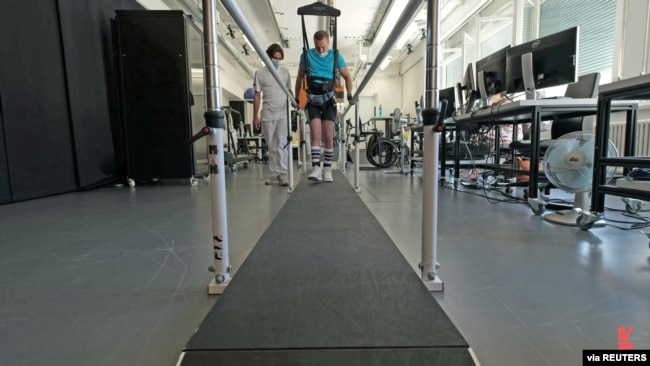脊髄してからの電気装置ということです。
素晴らしいですね!!
VOAで英語を学びましょう!!
知らなかった単語に出会えて♫
研究成果 :脊髄移植により半身不随者が再び歩けるようになることを発見(和訳)
Study: Spinal Cord Implant Helps Paralyzed People Walk AgainFeb 22,2022
研究者によると、3人のparalyzed patients麻痺患者に装着された新しい電気装置によって、彼らは再び歩けるようになったといいます。
3人の患者のthe lower bodies下半身は、spinal cord injuries脊髄損傷した後、麻痺したままになっていました。しかし、脊髄に埋め込んだ装置が筋肉に電気信号を送り、立ったり、歩いたり、運動したりすることを可能にしました。
この装置は、脳が脊髄に信号を送り、筋肉を動かすという脳の働きを真似るように設計されています。脊髄が脳の信号を受信すると、nerve cells神経細胞の集合体を刺激し、さまざまな筋肉を動かすことができます。
重篤な脊髄損傷を受けた患者さんでは、脳からのメッセージが神経に届きにくくなります。しかし、科学者たちは、筋肉を動かすための信号を受信し送信する神経は、損傷した患者でもまだ機能していることが多いことを発見しています。
脊髄損傷に関するこれまでの研究は、電気機器を使ってニューロンを刺激することが中心であったとNature 誌が報告しています。
今回の実験は、スイス連邦工科大学ローザンヌ校のグレゴワール・コートリーヌ氏とジョセリーヌ・ブロッシュ氏が主導しました。この結果は、Nature Medicine.誌に研究として発表されました。
実験には、オートバイの事故で負傷した男性3人が参加しました。患者の年齢は29歳、32歳、41歳です。The thoracic spine胸椎と呼ばれる首の下と背中の一番下にある部分の上部を負傷しました。
研究者によると、the spinal cord implants脊髄移植を受けた3人の患者さんは、移植後1時間以内に最初の一歩を踏み出すことができたといいます。
その後6カ月間で、患者さんはより高度な歩行活動に参加する能力を取り戻したとのことです。また、自転車に乗ったり、地域の中で泳いだりすることもできるようになりました。研究者らは、個人用電子機器を使用することにより、患者自身が神経刺激装置を制御することができると述べています。
イタリア出身のミシェル・ロカティさんは、患者の一人です。彼は、装置を使いながら踏み出した最初の一歩は、"とても感動的な体験だった "と記者団に語っています。ロカティさんは、今では数時間立っていられるし、1キロ近くも歩けるようになったと付け加えています。
他の研究者たちは、背骨の後ろから神経を刺激することによって、麻痺した患者の歩行を助けようと試みています。しかし、連邦工科大学のコートイン氏はロイターに対し、彼のチームは、信号が脊椎の側面から入るように装置を設計し直したと話します。この方法なら、脊髄の領域をより直接的に狙い、活性化させることができるといいます。
チームは次に、この装置に連動する人工知能(AI)システムを開発しました。AIは装置の電極を制御し、歩行などに必要な筋肉を制御する個々の神経を刺激する信号を送ります。
装置を埋め込むと、患者は”すぐに足を動かして歩けるようになった”と研究者のジョセリーヌ・ブロッシュ氏は話しています。
しかし、患者さんの筋肉は使われていないために弱っており、体重を支えるのに手助けが必要だと研究者はいいます。また、患者さんがこの技術を使いこなせるようになるまでには、多少の時間が必要でした。
患者たちは数種類の活動を行えるようになったとはいえ、完全に自然な動きを取り戻したわけではないと研究チームは述べています。それでもブロッシュ氏は、「彼らが訓練すればするほど、筋肉を持ち上げるようになればなるほど、より流動的になる 」と述べています。
ロッカティさんは、自宅で毎日インプラントを作動させ、より強くなり続けているといいます。「毎日、改善が見られます。」と彼は言い、「使用すると気分が良くなります。」と付け加えました。
Study: Spinal Cord Implant Helps Paralyzed People Walk Again
Researchers say a new electrical device placed in three paralyzed patients has helped them walk again.
The lower bodies of the three patients were left paralyzed after they suffered spinal cord injuries. But a device implanted in the spinal cord was able to send electrical signals to the muscles to permit them to stand, walk and exercise.
The device is designed to copy an action of the brain, in which it sends signals to the spinal cord that result in muscle movement. When the spinal cord receives the brain signals, it stimulates a collection of nerve cells that can activate different muscles.
In patients with serious spinal cord injuries, messages from the brain have difficulty reaching the nerves. But scientists have discovered that neurons – which receive and send signals for muscle movements – often still work in injured patients.
Past research into spinal cord injuries has centered on the use of electrical devices to stimulate neurons, the publication Nature reports.
Grégoire Courtine and Jocelyne Bloch of the Swiss Federal Institute of Technology in Lausanne led the latest experiments. The results were published in a study in Nature Medicine.
The experiments involved three men who had been injured in motor bike accidents. The patients ages were 29-, 32- and 41-years-old. Their injuries were to an area called the thoracic spine, which is below the neck and above the lowest part of the back.
The researchers reported that all three patients who got the spinal cord implants were able to take their first steps within an hour after receiving them.
Over the next six months, the patients regained the ability to take part in more advanced walking activities, the study found. They were also able to ride bicycles and swim in community settings. The individuals can control the nerve-stimulation devices themselves by using a personal electronic device, the researchers said.
Michel Roccati, from Italy, is one of the patients. He told reporters that the first step he took while using the device was “a very emotional experience.” Roccati added that he can now stand for several hours and walk nearly a kilometer.
Other researchers have attempted to help paralyzed patients walk by stimulating nerves through the back of the spine. But the Federal Institute of Technology’s Courtine told Reuters that his team redesigned the devices so signals would enter the spine from the sides. This method permits more direct targeting and activation of spinal cord areas, he said.
The team then developed artificial intelligence (AI) systems linked to the device. The AI controls electrodes on the device to send signals to stimulate individual nerves that control muscles needed for walking and other activities.
When the device was implanted, patients could "immediately activate their legs and step," said researcher Jocelyne Bloch.
However, because the patients’ muscles were weak from not being used, they needed help with supporting their weight, the researchers said. It also took some time for them to learn to work with the technology.
Even though the patients have the ability to perform several kinds of activities, the team said they did not regain completely natural movements. Still, Bloch said, "The more they train, the more they start lifting their muscles, the more fluid it becomes."
Roccati said he activates the implant daily at home and continues to get stronger. "I see the improvement every day," he said, adding, "I feel better when I use it."
Words in This Story
paralyzed – adj. unable to move part of the body such as arms or legs
implant – v. to place something into someone’s body in a medical operation
stimulate – v. to make something happen or develop more
advanced – adj. having developed or progressed to a late stage
artificial intelligence – n. an area of computer science that deals with giving machines the ability to seem like they have human intelligence
electrode – n. a conductor through which electricity enters or leaves an object, substance or region
